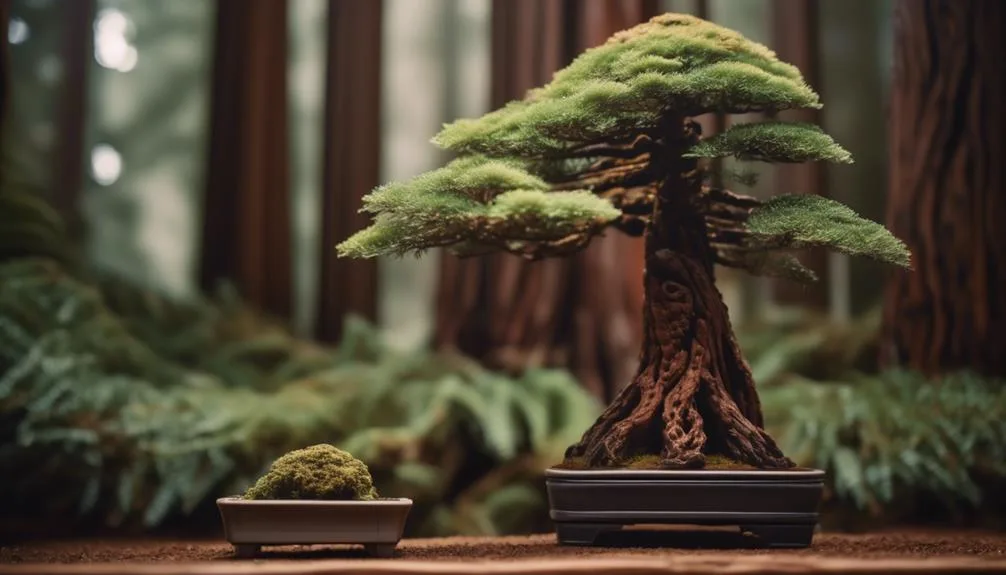Have you ever wondered if it's possible to transform a towering redwood tree into a miniature bonsai, capturing its grandeur on a small scale?
Surprisingly, with the right techniques, it's achievable. Shaping redwood trees into bonsai unlocks a world of creativity and horticultural craftsmanship.
Discover the intricate process and considerations involved in this fascinating endeavor.
Stay tuned to learn about the captivating art of turning these majestic giants into bonsai specimens.
Redwood Trees: Bonsai Potential
With their majestic height and resilient nature, redwood trees possess a remarkable potential for being shaped into beautiful bonsai specimens. The key to transforming these towering giants into miniature marvels lies in mastering the art of pruning.
Redwoods, known for their fast growth, can be trained and pruned to achieve the desired shape and size. Pruning techniques such as branch trimming, leaf pruning, and wiring are essential to guide the tree's growth and create the intricate, gnarled appearance characteristic of bonsai. This process allows for artistic expression, as each cut and bend contributes to the overall aesthetic of the bonsai.
Shaping Redwood Trees Into Bonsai
To shape redwood trees into bonsai, you will need to carefully apply pruning techniques and training methods to achieve the desired miniature form. Redwood trees, known for their grandeur, can be transformed into captivating bonsai, allowing for artistic expression through careful shaping. Pruning techniques such as directional pruning and bud pinching are essential for controlling the growth and form of the redwood bonsai. Additionally, training methods like wiring can help create the desired aesthetic by guiding the branches into elegant and harmonious shapes. Below is a table summarizing the key pruning techniques and training methods for shaping redwood trees into bonsai.
| Pruning Techniques | Description |
|---|---|
| Directional Pruning | Controls growth direction |
| Bud Pinching | Promotes ramification |
| Wiring | Shapes branches |
Suitable Redwood Varieties for Bonsai
Selecting the right redwood variety is crucial for creating stunning bonsai trees that showcase the unique characteristics of these majestic species.
When choosing a redwood variety for bonsai, consider the Coast Redwood (Sequoia sempervirens) and the Dawn Redwood (Metasequoia glyptostroboides).
Coast Redwoods are known for their graceful, upright growth and vibrant green foliage, while Dawn Redwoods display delicate, fern-like leaves and a more compact growth habit.
Both varieties are well-suited for bonsai, offering diverse options for aesthetics and techniques.
Keep in mind that redwood bonsai can range in size, from small tabletop specimens to larger outdoor displays.
These trees thrive in a moist, cool environment with dappled sunlight, mimicking their natural habitat.
Techniques for Bonsai Redwood Tree Care
Implementing proper pruning and wiring techniques is essential for maintaining the health and aesthetic appeal of your bonsai redwood tree. When pruning your redwood bonsai, focus on removing dead or overgrown branches to maintain its shape and promote new growth. Use sharp, clean tools to make precise cuts and avoid damaging the tree.
Additionally, wiring can be used to guide the shape of the tree and create the desired bonsai aesthetics. Carefully wrap the wire around the branches to gently bend and shape them.
As for soil composition, a well-draining mix with good moisture retention is crucial for the health of your bonsai redwood tree. Consider using a blend of akadama, pumice, and lava rock to provide the necessary nutrients and drainage.
Proper care and attention to pruning techniques and soil composition will ensure the longevity and beauty of your bonsai redwood tree.
Challenges of Bonsai Redwood Tree Maintenance
Maintaining the health and aesthetic appeal of your bonsai redwood tree presents certain challenges that require careful attention and expertise in pruning and soil composition.
When it comes to the care of your bonsai redwood tree, you may encounter the following challenges:
- Bonsai Styling: Achieving the desired bonsai style for a redwood tree can be challenging due to its rapid growth and unique branching patterns.
- Pruning Techniques: Redwood trees require specific pruning techniques to maintain their miniature size and shape while ensuring optimal health.
- Soil Composition: Finding the right balance of well-draining soil with adequate moisture retention can be challenging for redwood bonsai trees.
- Watering: Balancing the watering needs of redwood bonsai trees, which require moist soil without becoming waterlogged, can be a challenge.
- Disease and Pest Management: Redwood bonsai trees are susceptible to certain diseases and pests, requiring careful monitoring and proactive management.
Conclusion
Ultimately, with the right techniques and care, redwood trees can be shaped into stunning bonsai creations. Choosing the appropriate redwood variety and mastering the shaping and maintenance process are crucial for success.
Despite the challenges, a carefully crafted and maintained bonsai redwood tree adds a breathtaking and unique touch to any collection.
Happy bonsai gardening!
Mark Hoffman is a dedicated arborist and tree care specialist with over a decade of experience. His love for trees began when he visited Yosemite National Park as a teenager and was awestruck by the giant sequoias. Mark pursued his passion by studying forestry at Michigan Technological University, where he earned a Bachelor of Science degree.
Since then, he has worked tirelessly in the field of arboriculture, helping to preserve and protect trees in his community. His expertise and dedication have made him a respected leader in the industry and a valuable resource for anyone seeking advice on tree care.
